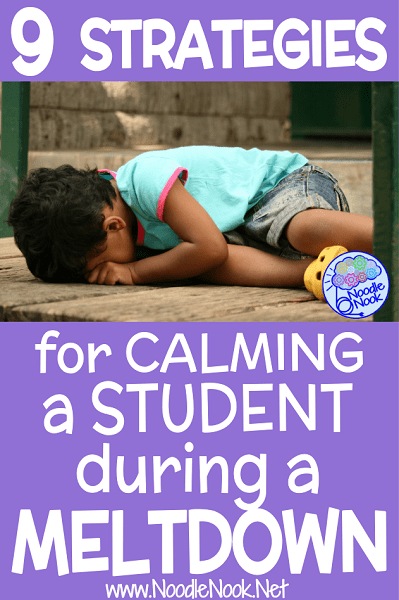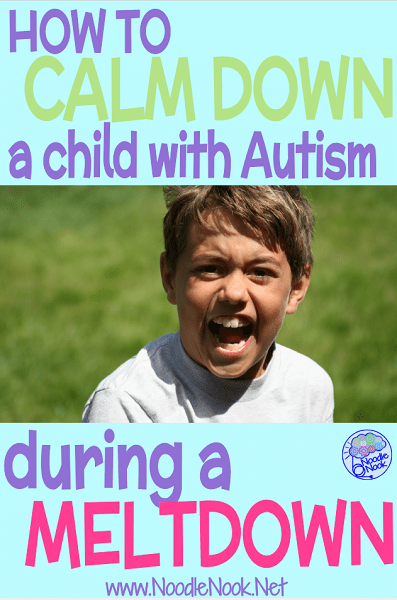9 Essential Classroom Tips to Calming in a Meltdown.
Whenever I think of a meltdown, I think of the girl from Charlie and the Chocolate Factory saying “I want an Oompa Loompa and I want it now!” As a mom, I immediately think of all the retorts I would have if I were there, but as a teacher I couldn’t tell a student the snarky comments I conjured up.
As a teacher we have to be the ones to make sure that demand doesn’t turn into a meltdown and lead to a child injuring themselves, harming others, or damaging property. We have to make sure that Oompa Loompa doesn’t send us to Urgent Care.
So what do you do when you have a student you need to calm down who is mid-meltdown? Here are a few tips and tricks when calming during a meltdown.
At the START of a Meltdown
Often times, a meltdown is started because a student did not get what they wanted when they wanted it. If a demand went unmet and a student is heading to meltdown-ville, then you would be well suited to do the following:
Start by not saying ‘no’.
‘No’ becomes the lighter fluid to the fire brewing inside. If you find yourself repeating ‘no’ over and over again, it is probably starting to grate on the student. They just don’t want to hear it. Instead, use some other language. “That is not an option right now”, or “Is that on the schedule for right now?” may get you further than a flat out ‘no’. It still retains home hope that the demand is not off the table. This is especially important once the meltdown has started… that ‘no’ is like throwing a pack of matches on a fire. Kaboom!
Next, try to give options to limit the demand.
If a student is demanding a cookie, but there are no cookies in sight, then try to give a student the choice of items available while still not saying no. “Do you want ice cream or an apple?” may work better than “There’s no cookies.” Remember, we are trying to deter the behavior before it escalates and turns into an all-out meltdown. Even once the meltdown starts to ramp up, offering options may help to give the student an out and allow them to realize there is something they want that they can have.
Finally, try some distractions.
When avoiding no and offering choices do not work and you can see a full meltdown on the horizon, then it’s time to try some distraction. It is amazing how focusing on the meltdown and bad behavior can increase that behavior. Sometimes focusing on other things can help break the chain of behavior and redirect attention. Try commenting on other things in the room, other people, or complimenting the student on something like clothes, hair, or work. We are trying to offer that ‘squirrel’ moment where we can distract long enough to let the embers cool and, hopefully, bring the meltdown to an end.
Beyond Demands
There are so many other triggers to behavior beyond not getting that Oompa Loompa. It is so important to be aware of the stimulus in the room at the time the meltdown starts and address it. You can do that by looking at the following:
Step 1…
First, how are the lights and sounds in the room? Has the physical environment triggered something? If you can see the start of a meltdown, or even in the midst of one, quiet the room and dim the lights. The sensory over-stimulation can escalate a behavior quickly. Sometimes that sensory relief can cue calming behavior.
Step 2…
Next, lower the volume of your voice, calm the tone and slow the cadence… in other words, talk slower, softer and quieter. I worked with a student who would have a meltdown every time he heard a certain person talking. Something about her voice made him scream, holler, cover his ears, and, if left unchecked, self-injure. It would even happen if he heard her talking out in the hall or next door. Auditory input matters, so reflect.
Step 3…
Then, it isn’t just how you are saying things, but how much talking you’re doing. When a student has a sensory processing disorder, like students with Autism, they are hypersensitive to sensory input. When the room is noisy, the lights are bright, and cognitive demands are high, it doesn’t take much to fall over the edge. It doesn’t help when we come over adding to the load… “Sweetie, what is the matter? What is wrong? Are you okay?” That is just too darn much. Don’t say 20 words when you can say two… or when you can show a visual instead.
Step 4…
Along with that, and a final tip in this section, is to use a compliance task to lessen the cognitive load. When the work is tough and a student is also dealing with all the other things in the room, sometimes they just need a little mental break and to feel success. Keep a compliance activity, which is a simple and quick activity a student can do independently, handy to allow the student a quick win, keep them working, and lower the cognitive load while they internally calm down. A compliance task is also a great tool to use after a meltdown to transition a student back to work without overloading them or sending them back into a meltdown.
During and After a Meltdown
Two things you are going to want to have when a student is in or just after a meltdown are support and a calming sequence.
Get support or have access to support when a student is melting down. I know this is not always possible for every teacher in every classroom with every student that blows up, but in today’s litigious society, whenever a student shows the potential to injure themselves, injure others, or damage a lot of property, we want a witness. So get someone else in the room.
Finally, be sure to have a calming sequence to reference or a calming chain of behavior you can initiate. Maybe that is to take 5 deep breaths and count to twenty. Maybe it is to go to the calming corner of the room and write in a journal. I have used both, it will just depend on the student. If you have a student who is prone to meltdowns, you want to teach the calming behavior when they are calm, not when they are mid-melt. Do that with a good social story and some good direct instruction. Here is a story you can use to talk about not hurting self, others, or damage property as well as using a calming corner, taking deep breaths, and counting to calm down. Implementing that chain of behavior as a way to circumvent a meltdown really does help.
Calming in a Meltdown
When it comes to calming students in a meltdown, try the following strategies:
- Avoid saying ‘No’
- Offer Choice
- Limit Demands
- Use Distractions
- Check the Environmental Stimulus
- Talk Lower, Softer and Quieter
- Use Less Language
- Get Support/a Witness
- Have a Calming Sequence
When you put all these things together and start to work out the most effective tactics for specific students, I know you can be successful at calming in a meltdown.
Stay strong and teach on!
Are you looking for more information to address behaviors in your classroom or classroom management? No problems, we’ve literally been there. Try these essential articles:
- Learn about the Function of Behavior (so you know how to address it better).
- Are you using Token Boards? They’re an essential classroom tool. Check out more here.
- Are you feeding the behavior? Learn about Breaking the Chain of Bad Behavior.
And if you still want more, be sure to join our monthly newsletter! I share tips, tricks and FREE tools every month. Join now!





